October itinerary in Japan Day 4 (Fukui Day 2)
(Saturday, October 23)
Table of contents
4. Former Morita Bank Head Office
1. Tojinbo
I went to Tojinbo by Echizen Railway and bus in the morning of the 4th day of my trip. The Echizen Railway runs about once every 20-30 minutes. The trains I boarded are as follows.
Depart Fukui Station at 7:23, Echizen Railway Mikuni Ashihara Line, bound for Mikuni Minato, and arrive at Mikuni Minato station at 8:14.
The ticket from Fukui Station to Mikuni Minato Station is Yen 770. I bought a one-day free ticket only on Saturdays, Sundays and public holidays. All-you-can-ride Echizen Railway for one day is Yen 1,000 for adults (junior high school students and above) and Yen 500 for children, so it’s quite cheap if you go back and forth between Fukui Station and Mikuni Minato.
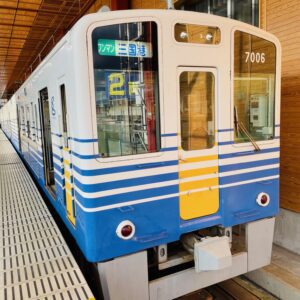
The Echizen Railway vehicles were pop-colored. On the other hand, the station building of Mikuni Minato Station is an unmanned station and is quite retro. I headed to Tojinbo from the bus stop about 3 minutes on foot from Mikuni Minato station. The buses I boarded are as follows.
Depart Mikuni Minato Station at 8:36, 87 Ashihara Maruoka Eiheiji Line, arrive at Tojinbo 8:41, fare Yen200
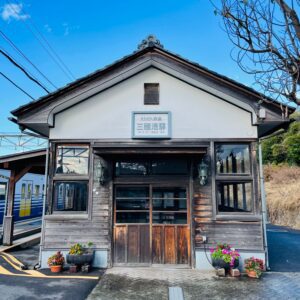
Tojinbo is a national scenic spot and a natural monument. Columnar joints continue for about 1 km. The steep rock wall is about 25m at the highest point. However, the “Umanose” (columnar joint, national natural monument) in Miyazaki prefecture that I visited before is about 70m high, and the Takachiho Gorge (columnar joint, national scenic spot / natural monument) in the same Miyazaki prefecture is also high. The joint reaches 80-100m. Tojinbo is less than half the height of Umanose and Takachiho Gorge, so I felt that Tojinbo was not so great in comparison. I think that Tojinbo can feel the height of the cliff more on the west side such as candle rock. However, the ground on the west side is not good, so be careful not to slip it off.
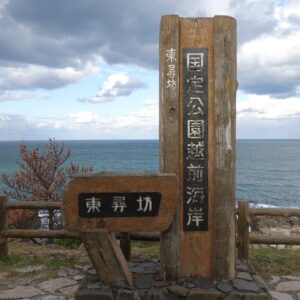
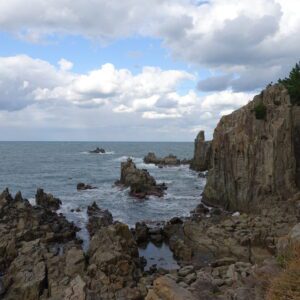

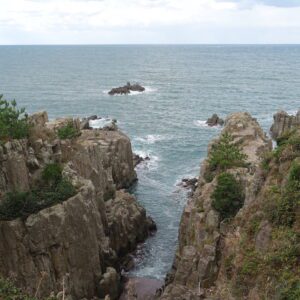
Tojinbo is the name of a monk pushed down from this cliff. A monk named Tojinbo has been doing bad things and seems to have been resented by his colleague’s monk. The origin of Tojinbo’s name is interesting.
There is no admission fee for Tojinbo.
2. Takidanji Temple
After visiting Tojinbo, I went to Takidanji Temple. The buses I boarded are as follows.
Depart Tojinbo at 9:20, 85 Tojinbo Line, arrive at Mikuni toshokan 9:31, fare Yen 320
After getting off at Mikuni toshokan, walk for less than 10 minutes to reach Takidanji Temple. Takidanji is a national important cultural property and a scenic spot. It was founded in 1375 by Eiken Shonin of Kishu Negoroji Temple. The main hall, Kannon-do, and Sanmon are wonderful and I think they are worth visiting. At the main hall, the people at the temple explain about Takidan-ji for free.

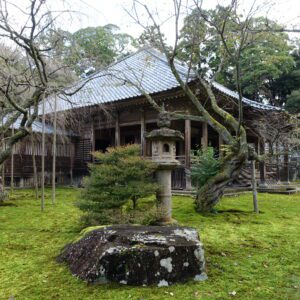
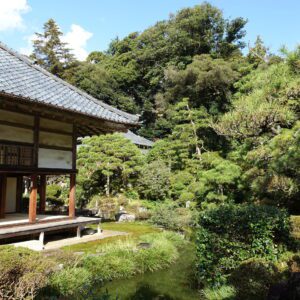
Due to the leaking work of the treasure hall, it was not possible to see the national treasure, Kondo hosoge monkei (Gold and Bronze Treasure Soka Bianqing) (Heian period 794-1185 ringer).
Admission fee: Yen 500 for adults, Yen 300 for junior and senior high school students, Yen 200 for children
3. Old Kishina Family Home
Next, I went to the Old Kishina Family Home, which is about a 15-minute walk from Takidanji Temple. Mikuni, where Tojinbo, Takidanji, and the Old Kishina Family are located, was the base of the Kitamaebune (mainly purchased goods in the Sea of Japan), and prospered greatly. The Kishina family ran a lumber dealer in those three countries. It is a “Kagura-date” townhouse with a Hirairi Omoteya in front of Kirizuma-zukuri style. The Old Kishina Family Home is a national tangible cultural property.
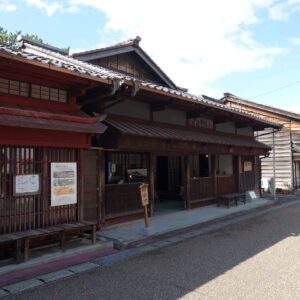
Admission: Yen100
4. Former Morita Bank Head Office
The Former Morita Bank Head Office is a 1-minute walk from the Old Kishina Family Home. Morita Bank was established as the head office in 1920 by the Morita family, a wealthy merchant in Mikuni. The exterior and interior design of the former Morita Bank head office was wonderful. I think the interior is as wonderful as the Bank of Iwate Red Brick Building in Morioka City. The visit is well worth it. The Former Morita Bank Head Office is a national tangible cultural property.
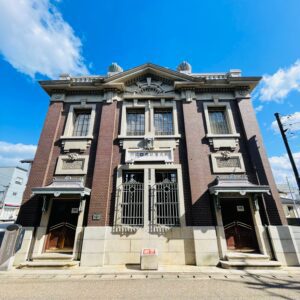
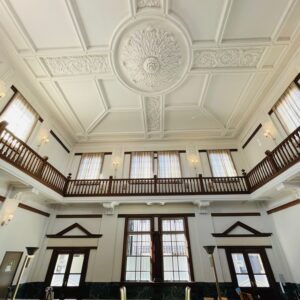
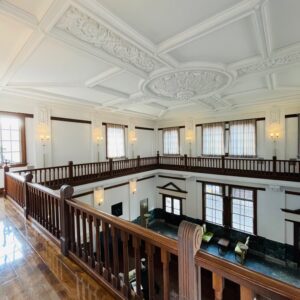
Admission: Free
5. Fukui station
After visiting the former Morita Bank head office, I returned to Fukui station after drinking local sake. The trains I boarded are as follows.
Depart Mikuni Station at 11:11, Echizen Railway for Mikuni Ashihara Line, bound for Fukui, arrive at Fukui Station at 12:01, fare Yen 730 (however, I purchased a “one-day free ticket“)
Around Fukui Station, you can enjoy dinosaur monuments, sitting dinosaur doctors, and dinosaur trick art.

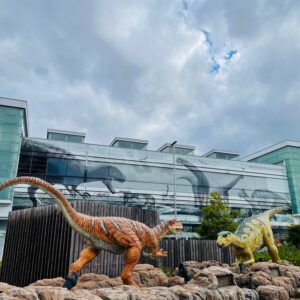
Fukui Prefecture has the highest number of dinosaur fossils excavated in Japan (about 80% of the total in Japan), and is attracting tourists as “Dinosaur Kingdom Fukui”. I think the existence of dinosaurs around Fukui Station is a very unique and wonderful initiative.
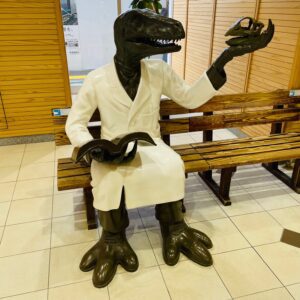

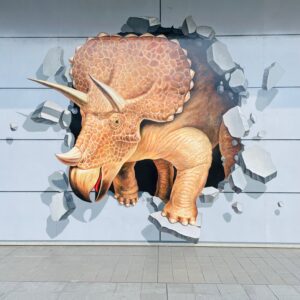
6. Daianji Temple
After lunch, I went to Daianji Temple (Daianzenji Temple). The buses I boarded are as follows.
Depart Fukui Station at 13:13, 10 Echizen Kaigan Blue Line, arrive at Daianji Monzen at 13:34, fare Yen 420
After getting off at the bus stop in front of Daianji Temple, it takes less than 15 minutes on foot to reach Daianji Temple.
The main hall, mountain gate, and mausoleum of Daianji Temple are a national important cultural property. Daianji Temple was built in 1658 by the 4th Fukui feudal lord Matsudaira Mitsumichi as the permanent family temple of the Fukui feudal lord Matsudaira family. There is a mausoleum of successive feudal lords of Fukui, commonly known as “Senjojiki”. Unfortunately, the main hall and the mountain gate were under repair. “Senjojiki” is located on a steep slope for about 5 minutes. It was a mausoleum with a quiet atmosphere.
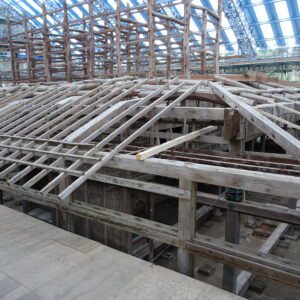
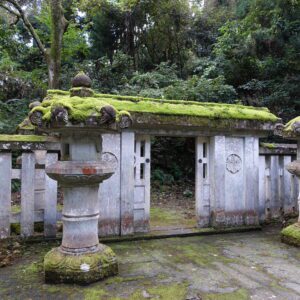
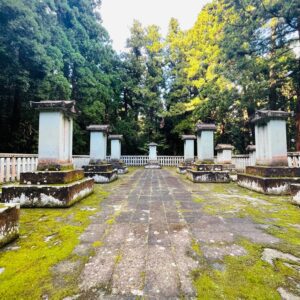
Admission fee: Adults Yen 500, university students Yen 400, junior high and high school students Yen 300, elementary school students Yen 200
7. Yokokan Garden
After returning to Fukui Station and drinking craft beer, I went to Yokokan Garden. The bus I got on from Daianji is as follows.
Depart Daianji Monzen at 14:33, 10 Echizen Kaigan Blue Line, arrive at Fukui Station at 14:53, fare Yen 420
It is a little over 10 minutes walk from Fukui Station to Yokokan Garden.
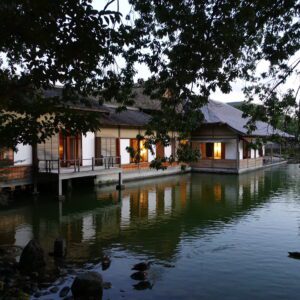
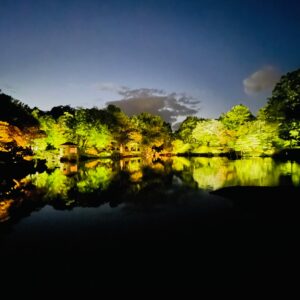
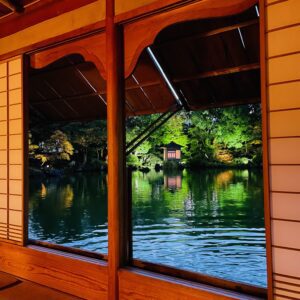
Yokokan Garden is a stroll style garden with a sukiya-style mansion and is a national scenic spot. It used to be the villa of the Matsudaira clan, the lord of the Fukui domain.
At the time of my visit (October 23rd), “Autumn Light Up” (October 1st to November 7th) was held, and the view from the mansion was wonderful. It was a wonderful view, but I was disappointed that there were few visitors. It is a garden that I would like many people to visit.
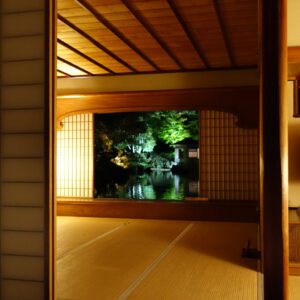
Admission fee: Yen 220
8. Sakaenoyashiro
When I left the Yokokan garden and walked to Fukui station, I happened to find Sakaenoyashiro, which hung beautiful crane origami paper. Crane origami is about 120,000. The deities are Hideyasu Matsudaira, the ancestor of the Fukui domain, Ieyasu Tokugawa, the first general of the Edo Shogunate, and Yoshinaga Matsudaira (Shungaku), the 16th lord of the Fukui domain.
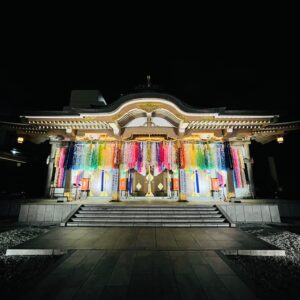
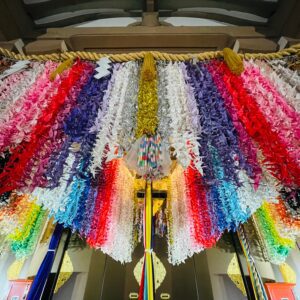
Note: The departure / arrival times, fees, and admission fees for transportation listed in the text are as of the time of writing the BLOG. Please check for yourself when you go on a trip as it may change in the future.